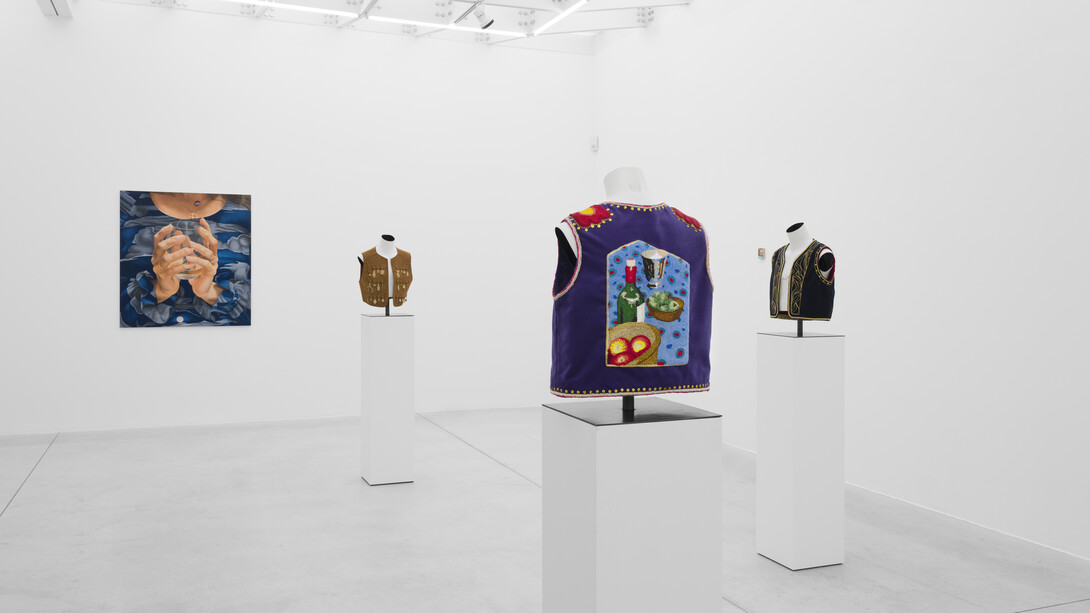L’invité.e surprise is the first solo exhibition in Belgium by Solène Rigou (b. 1996, Paris). Presented across the first two rooms of the gallery, her wood drawings, intimate in scale and icon-like in dimension, require particular attention to fully grasp the scope of the work. In the back room, the installation plays more freely with scale and also reveals three jackets designed by the artist—unexpected and humorous counterpoints to her works on wood.
On the ground floor, the works initially appear photographic. This illusion fades only as one moves closer and begins to examine the intricate details of each scene. Technically—since it is appropriate to speak of technique at some point—the work is remarkable: that of a virtuoso. Yet its strength lies not only in skill. While many artists today have turned toward hyperrealism or trompe-l’œil, few succeed in bringing their works to life as Solène Rigou does. Her singularity lies in two observations: technical (her know-how is truly exceptional) and iconographic (her choice of subjects is singular and repetitive). Savoir-faire and savoir-juger, to paraphrase the art historian Daniel Arasse.
Drawn to light and shadow, Solène Rigou has found in pale poplar wood the ideal support to achieve a luminosity that neither paper nor canvas can offer. The wood, with its grain, texture, and imperfections, inspires the dreaming hand. Although the artist works exclusively with colored pencils, she draws in the manner of the Flemish painters of the fifteenth century, applying pigment layer after layer, like glazes, until full color saturation is achieved. Hence this brilliance and depth in the drawn material. Like her illustrious predecessors, she takes evident pleasure in the representation of materials (leather, silk, mohair, gold, silver, stones), effects (transparency, shadows, folds), flowers and plants, patterns (striped, checkered), anatomical details (complexion, hair, nails, veins, lines of the hand). Through this process of successive layers, she resists the pursuit of quick results, flashy production, and the quest for effect that has gradually dominated contemporary practice. Her work aligns instead with craftsmanship, the repetitive gesture, the artist who carries within her “all the glory of the worker,” as Bachelard put it. Solène Rigou draws hands by hand. Certainly, there is an effect (mimetic resemblance is an effect), but one that is developed slowly, meticulously, and with quiet persistence.
The savoir-juger can be understood through the choice of her subjects, which in turn sheds light on her artistic approach. Solène Rigou draws only hands. As important as the figure itself, they are among the most difficult things to draw; they are what tell the story of a person. For her, hands are portraits. Moreover, the title of each drawing is the first name of the friend whose hand is represented. To draw hands is to speak of truth. As the poet Pierre Reverdy wrote, “The hand sums up the psychic man, perhaps even more than the face, which can be trained, masked, and deceitful. The hand does not lie.”
In Solène Rigou’s work, the hands are generally life-sized and are based on photographs taken by the artist herself, often spontaneously, never posed, sometimes in secret. They capture fleeting moments of life, of shared intimacy, imbued with the artist’s personal memories yet open to the viewer’s imagination. Through detail, she opens up a world. While continuing the tradition of mimesis in painting—the truth of detail—she breathes into her work a dose of strange, sustained by its narrative potential. Detail enlarges things and opens up wandering thoughts. By fixing the moment, Solène Rigou captures a lived experience, reawakens it through drawing and, before offering it to the imagination of a future viewer, reclaims control over the temporality of the moment. It is the ordinary transformed into the universal. It restores significance to the tenderness of moments lived by all, ephemeral moments that often go unnoticed.
Close to the Flemish Primitives in the miniaturization of the world, Solène Rigou is also linked to the Italian Primitives in her sensitivity to the language of gestures. Consider Giotto’s saints and angels: hands open or clasped, fearful or calm, praying, pointing, offering, blessing, healing, cutting, receiving the stigmata. Rigou shares this fascination with the language of hands, giving consciousness to their state—whether at work or at rest. The hand acts; it carries within it an action in the making.
In an age dominated by machines, some may argue that manual skill has lost its place. But in observing the work of Solène Rigou, one can appreciate that the ancient gesture of the hand still endures among artists. And there is something deeply joyful in seeing this choreography of the hand celebrated, in both its act and its transmission.














